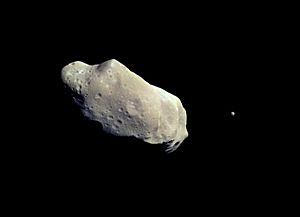Asteroid moon facts for kids

The asteroid 243 Ida and its moon Dactyl.
An asteroid moon is a smaller asteroid that travels around a larger asteroid. Think of it like our Moon orbiting Earth, but on a much smaller scale! These moons are quite special because they are not very common. Scientists believe that only about 2 out of every 100 asteroids have a moon.
For an object to be called an asteroid moon, it must be smaller than the asteroid it orbits. If two asteroids are almost the same size and orbit each other, they are called a binary pair. It's like having two partners dancing together in space!
| The Solar System | |||||||
|---|---|---|---|---|---|---|---|
|
|
|||||||
| Sun • Heliosphere |
Planets ☾ = moon(s) ∅ = rings |
Mercury | Venus | Earth ☾ | Mars ☾ | ||
| Jupiter ☾ ∅ | Saturn ☾ ∅ | Uranus ☾ ∅ | Neptune ☾ ∅ | ||||
| Dwarf planets | Ceres | Pluto ☾ | Haumea ☾ | Makemake | |||
| Eris ☾ | |||||||
| Small Solar System bodies |
Asteroids (minor planets) |
Groups and families: Vulcanoids · Near-Earth asteroids · Asteroid belt Jupiter Trojans · Centaurs · Neptune Trojans · Asteroid moons · Meteoroids · Pallas · Juno · Vesta · Hygiea · Interamnia · Europa |
|||||
| See also the list of asteroids. | |||||||
| Trans- Neptunians |
Kuiper belt – Plutinos: Orcus · Ixion – Cubewanos: Varuna · Quaoar · Huya |
||||||
| Scattered disc: Sedna | |||||||
| Comets | Periodic comets and non-periodic comets Damocloids · Oort cloud |
||||||
| See also the list of solar system objects | |||||||
Images for kids
See also
 In Spanish: Satélite asteroidal para niños
In Spanish: Satélite asteroidal para niños

All content from Kiddle encyclopedia articles (including the article images and facts) can be freely used under Attribution-ShareAlike license, unless stated otherwise. Cite this article:
Asteroid moon Facts for Kids. Kiddle Encyclopedia.

